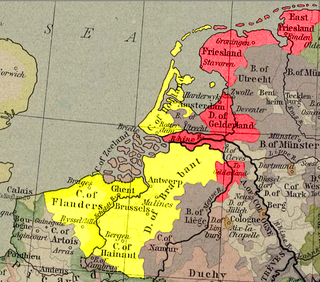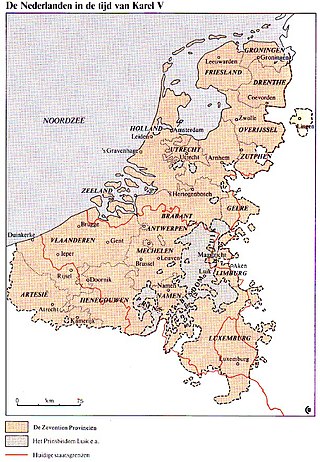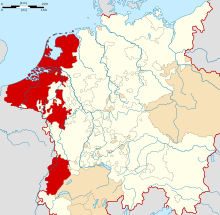The Union of Utrecht was a treaty signed on 23 January 1579 in Utrecht, Netherlands, unifying the northern provinces of the Netherlands, until then under the control of Habsburg Spain.

The Seventeen Provinces were the Imperial states of the Habsburg Netherlands in the 16th century. They roughly covered the Low Countries, i.e., what is now the Netherlands, Belgium, Luxembourg, and most of the French departments of Nord and Pas-de-Calais (Artois). Also within this area were semi-independent fiefdoms, mainly ecclesiastical ones, such as Liège, Cambrai and Stavelot-Malmedy.

The Southern Netherlands, also called the Catholic Netherlands, were the parts of the Low Countries belonging to the Holy Roman Empire which were at first largely controlled by Habsburg Spain and later by the Austrian Habsburgs until occupied and annexed by Revolutionary France (1794–1815).
The Pragmatic Sanction of 1549 was an edict, promulgated by Charles V, Holy Roman Emperor, reorganising the Seventeen Provinces of the present-day Netherlands, Belgium, and Luxembourg into one indivisible territory, while retaining existing customs, laws, and forms of government within the provinces.

The County of Hainaut, sometimes spelled Hainault, was a territorial lordship within the medieval Holy Roman Empire that straddled the present-day border of Belgium and France. Its most important towns included Mons, now in Belgium, and Valenciennes, now in France.

The County of Artois was a historic province of the Kingdom of France, held by the Dukes of Burgundy from 1384 until 1477/82, and a state of the Holy Roman Empire from 1493 until 1659.

In the history of the Low Countries, the Burgundian Netherlands or the Burgundian Age is the period between 1384 and 1482, during which a growing part of the Low Countries was ruled by the Dukes of Burgundy. Within their Burgundian State, which itself belonged partly to the Holy Roman Empire and partly to the Kingdom of France, the dukes united these lowlands into a political union that went beyond a personal union as it gained central institutions for the first time.

Spanish Netherlands was the Habsburg Netherlands ruled by the Spanish branch of the Habsburgs from 1556 to 1714. They were a collection of States of the Holy Roman Empire in the Low Countries held in personal union by the Spanish Crown. This region comprised most of the modern states of Belgium and Luxembourg, as well as parts of northern France, the southern Netherlands, and western Germany with the capital being Brussels. The Army of Flanders was given the task of defending the territory.

The Duchy of Limburg or Limbourg was an imperial estate of the Holy Roman Empire. Much of the area of the duchy is today located within Liège Province of Belgium, with a small portion in the municipality of Voeren, an exclave of the neighbouring Limburg Province. Its chief town was Limbourg-sur-Vesdre, in today's Liège Province.

The Duchy of Luxembourg was a state of the Holy Roman Empire, the ancestral homeland of the noble House of Luxembourg. The House of Luxembourg, now Duke of Limburg, became one of the most important political forces in the 14th century, competing against the House of Habsburg for supremacy in Central Europe. They would be the heirs to the Přemyslid dynasty in the Kingdom of Bohemia, succeeding the Kingdom of Hungary and contributing four Holy Roman Emperors until their own line of male heirs came to an end and the House of Habsburg got the pieces that the two Houses had originally agreed upon in the Treaty of Brünn in 1364.

The Guelders Wars were a series of conflicts in the Low Countries between the Duke of Burgundy, who controlled Holland, Flanders, Brabant, and Hainaut on the one side, and Charles, Duke of Guelders, who controlled Guelders, Groningen, and Frisia on the other side.

The House of Valois-Burgundy, or the Younger House of Burgundy, was a noble French family deriving from the royal House of Valois. It is distinct from the Capetian House of Burgundy, descendants of King Robert II of France, though both houses stem from the Capetian dynasty. They ruled the Duchy of Burgundy from 1363 to 1482 and later came to rule vast lands including Artois, Flanders, Luxembourg, Hainault, the county palatine of Burgundy (Franche-Comté), and other lands through marriage, forming what is now known as the Burgundian State.

The County of Zeeland was a county of the Holy Roman Empire in the Low Countries. It covered an area in the Scheldt and Meuse delta roughly corresponding to the modern Dutch province of Zeeland. The County of Zeeland did not include the region of Zeelandic Flanders which was part of Flanders; conversely, the modern Province of Zeeland does not include Sommelsdijk, historically part of the County of Zeeland.

Habsburg Netherlands was the Renaissance period fiefs in the Low Countries held by the Holy Roman Empire's House of Habsburg. The rule began in 1482, when the last Valois-Burgundy ruler of the Netherlands, Mary, wife of Maximilian I of Austria, died. Their grandson, Emperor Charles V, was born in the Habsburg Netherlands and made Brussels one of his capitals.
The Burgundian treaty of 1548, also known as the Transaction of Augsburg, settled the status of the Habsburg Netherlands within the Holy Roman Empire.

The War of the Burgundian Succession took place from 1477 to 1482, immediately following the Burgundian Wars. At stake was the partition of the Burgundian hereditary lands between the Kingdom of France and the House of Habsburg, after Duke Charles the Bold had perished in the Battle of Nancy on 5 January 1477.

Netherlands–Spain relations are the bilateral relations between the Netherlands and Spain. The relations between both countries are defined mainly by their membership in the European Union and by being allies in the NATO.

The Burgundian State is a concept coined by historians to describe the vast complex of territories that is also referred to as Valois Burgundy.

Gewest is a Dutch term often translated as "region". It was used to describe the various different polities making up the Low Countries, which covered what is now the Netherlands, Belgium, Luxembourg and parts of northern France, until the annexation by France in the late 18th century. The term is now mostly associated with the official titles of the constituent states of Belgium.




















